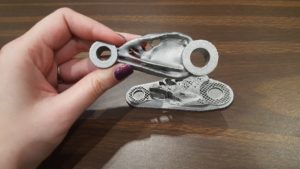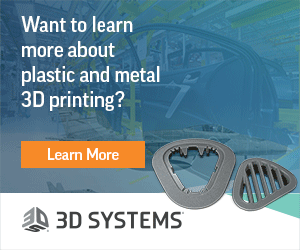 A lot of exciting announcements have been coming out of SOLIDWORKS World this week. HP announced a new full-color 3D printing system, while Nano Dimension and Rize both announced new or expanded partnerships with Dassault Systèmes’ SOLIDWORKS brand. Each of those partnerships has a different focal point, and today it’s Desktop Metal’s turn. The young company is partnering with SOLIDWORKS to advance design for additive manufacturing (DfAM) through education, with a focus on educational initiatives and the development of advanced tools for generative design.
A lot of exciting announcements have been coming out of SOLIDWORKS World this week. HP announced a new full-color 3D printing system, while Nano Dimension and Rize both announced new or expanded partnerships with Dassault Systèmes’ SOLIDWORKS brand. Each of those partnerships has a different focal point, and today it’s Desktop Metal’s turn. The young company is partnering with SOLIDWORKS to advance design for additive manufacturing (DfAM) through education, with a focus on educational initiatives and the development of advanced tools for generative design.
“The art of fabricating metal parts into the hands of everyone. That’s not an easy feat,” said Gian Paolo Bassi, CEO, SOLIDWORKS, Dassault Systèmes, in a press conference at SOLIDWORKS World. “Not everybody 3D prints metal. It takes a lot of intellectual property to make it right. The reason why we are working stronger together is because a successful 3D printing – especially metal 3D printing – strategy is to work hand in hand with a partner in applications. This is why we are working together, to master the capability for metal 3D printing. If you don’t know what you do, 3D printed parts may not come exactly to specification. Design and fabrication has to work hand in hand. We know this very well, why they’re building a partnership with us, amazing applications for generative design.”
Desktop Metal previewed a new software tool called Live Parts, a new solution to simplify generative design for 3D printing. It applies morphogenetic principles and advanced simulation to shape strong, lightweight parts in only minutes. It auto-generates designs in real time, powered by a GPU-accelerated multi-physics engine. It allows users to take advantage of all the benefits of 3D printing, including design flexibility and material and cost efficiency. Users don’t need to have any prior experience or knowledge of additive manufacturing to use the tool, which produces functional parts with complex geometries.
“3D printing begins with the design. It’s a full production lifecycle,” said Jonah Myerberg, CTO and Co-Founder of Desktop Metal. “Our single goal at DM was to make metal 3D printing more accessible…3D printing really sits at the intersection of the physical and the digital world. It brings the designer closer to the finished part, arguably one step closer than traditional tooling. This environment in which the CAD designer is living is really connected to metal 3D printing.”
“We’re trying to create parts that take advantage of AM yet engineers don’t know what that means,” added Andy Roberts, Senior Software Engineer at Desktop Metal. “We don’t want engineers to have to learn a whole new technique to create parts. In nature, no one sketches a tree, designs a tree and puts it in place. Everything starts with cells that grow…as it’s growing, it’s adapting to its environment in real time. What’s interesting in nature is that nothing happens in a vacuum; everything is constantly changing and constantly evolving. We need to create a more nature-based tool that can generate these parts automatically. We’ve essentially created a system where we grow parts. This is a radical approach: no one has tried to do quite that. There’s a lot of biomimicry. No one has said, let’s actually create the mechanism that makes cells and animals grow in nature.”
- A part created with Live Parts
Starting today, an early stage version of Live Parts will be available to all SOLIDWORKS users to preview and provide feedback. Live Parts isn’t the only aspect of the partnership between Desktop Metal and SOLIDWORKS, however; the two are also working together to pursue a variety of educational initiatives, including metal 3D printing certification and curriculum and joint content programs. They’ll also be collaborating on features that allow users to have a full additive workflow from design through 3D printing.
“Advances in 3D technology from 3D printing to materials science are driving tremendous growth for key industries, particularly as applications shift towards production,” said Bassi. “Partnering with an industry pioneer like Desktop Metal will help our customers to take the guesswork and complexity out of developing products specifically for additive manufacturing – empowering engineers and designers to accelerate complex and critical design applications.”
Discuss this and other 3D printing topics at 3DPrintBoard.com or share your thoughts below.
[Images: Sarah Goehrke]
Subscribe to Our Email Newsletter
Stay up-to-date on all the latest news from the 3D printing industry and receive information and offers from third party vendors.
You May Also Like
Gorilla Sports GE’s First 3D Printed Titanium Cast
How do you help a gorilla with a broken arm? Sounds like the start of a bad joke a zookeeper might tell, but it’s an actual dilemma recently faced by...
Nylon 3D Printed Parts Made More Functional with Coatings & Colors
Parts 3D printed from polyamide (PA, Nylon) 12 using powder bed fusion (PBF) are a mainstay in the additive manufacturing (AM) industry. While post-finishing processes have improved the porosity of...
$25M to Back Sintavia’s Largest Expansion of Metal 3D Printing Capacity Since 2019
Sintavia, the digital manufacturing company specializing in mission-critical parts for strategic sectors, announced a $25 million investment to increase its production capacity, the largest expansion to its operations since 2019....
Velo3D Initiates Public Offering in a Bid to Strengthen Financial Foundations and Drive Future Growth
Velo3D (NYSE: VLD) has been among a number of publicly traded 3D printing firms that have attempted to weather the current macroeconomic climate. After posting a challenging financial report for 2023,...


































